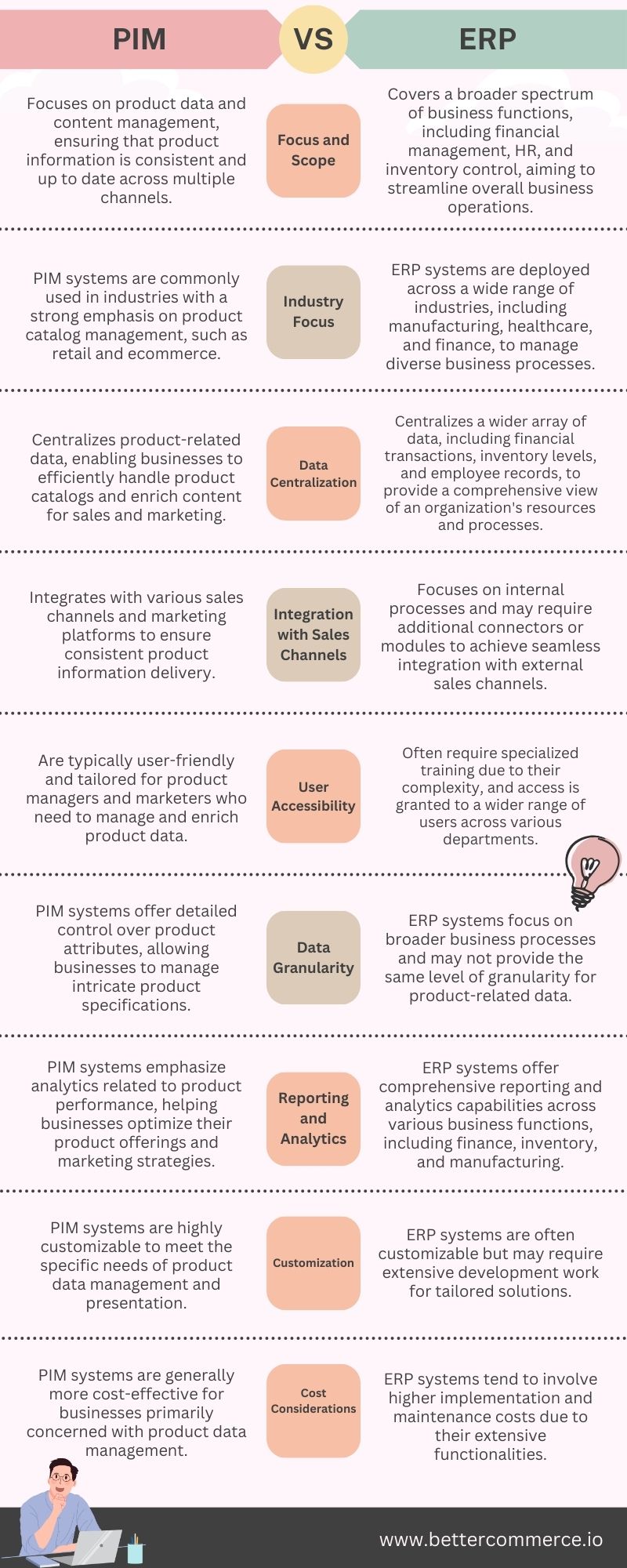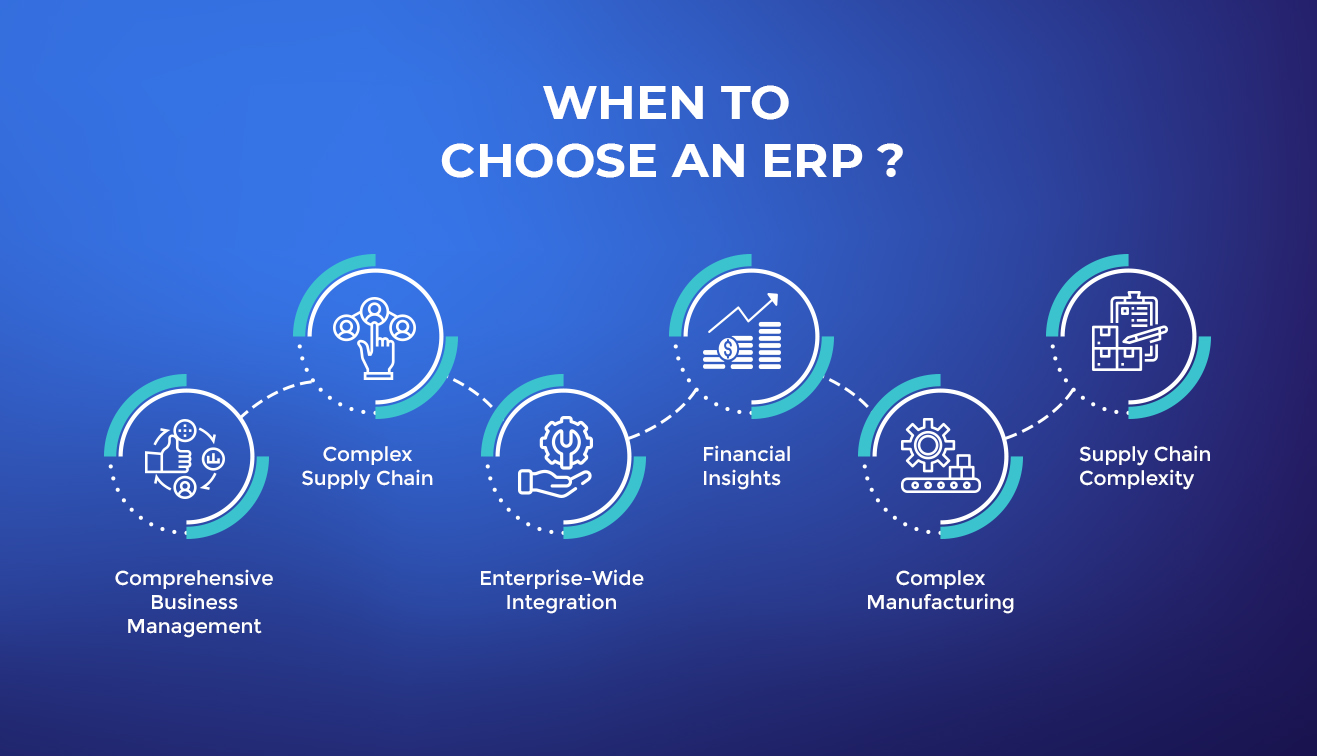In today's rapidly evolving business landscape, where data and information management are paramount, choosing the right tools is crucial for success. Two of the most important systems in this regard are Product Information Management (PIM) and Enterprise Resource Planning (ERP). While both PIM and ERP systems play pivotal roles in streamlining business operations, they serve distinct purposes.
Let’s explore the differences, similarities, and how these two solutions can complement each other for efficient business management.
What is PIM?
PIM is a dedicated software solution designed to centralize and manage product-related data and content. PIM systems excel in organizing and enriching product information, including specifications, images, descriptions, and pricing, to ensure consistency and accuracy across various sales channels.
What is ERP?
ERP is a comprehensive software solution that integrates and manages various business processes across an organization. ERP systems encompass a wide range of functionalities, including finance, HR, inventory, manufacturing, supply chain, and more. They serve as a central hub for managing critical business data and automating workflows.
Key Differences between PIM and ERP

Finding the Right Balance
In the PIM vs ERP debate, it's not about choosing one over the other; it's about finding the right balance for your business needs. PIM is indispensable for managing product data and ensuring consistent messaging across sales channels. ERP, on the other hand, provides a holistic view of your business operations.
When to Choose a PIM?
Choose a PIM system when your primary focus is on managing and presenting product-related data, especially if you are in industries like retail or e-commerce. PIM is ideal for:
- Maintaining Product Consistency: When you need to ensure that product information, such as descriptions, images, and prices, remains consistent across various sales channels.
- Large Product Catalog: If you have a diverse and extensive product catalog with many variations, a PIM system can help organize and enrich this data efficiently.
- Digital Marketing: PIM systems are valuable for digital marketing efforts, ensuring that your product information is accurate and appealing to customers online.
- E-commerce Emphasis: If your business relies heavily on e-commerce and online sales, a PIM system can help you effectively manage and optimize product data for digital channels.
- Digital Asset Management: PIMs are well-suited for businesses with a large volume of digital assets, such as images, videos, and product-related content, which require organization and easy retrieval.
- Content Enrichment: If you need to enhance product information with detailed descriptions, specifications, and marketing content to engage customers, a PIM system provides the necessary tools.
- Data Syndication: PIM systems excel at distributing product data to various sales channels and marketplaces, ensuring that your products are presented consistently across the digital landscape.
- Multichannel Sales: PIM systems bring about consistency among all your sales touchpoints and provide an omnichannel experience. You can manage all your sales touchpoints through a single dashboard.
When to Choose an ERP?
PIM and ERP systems are a dynamic duo that can seamlessly complement each other.
Select an ERP system when you need to manage broader aspects of your business beyond just product data. ERP is suitable for:
- Comprehensive Business Management: When you require a centralized system to handle various business functions such as finance, inventory, HR, and supply chain management.
- Complex Supply Chain: ERPs excel at managing supply chains, procurement, and inventory control, making them essential for businesses with intricate supply chain needs.
- Enterprise-Wide Integration: ERPs are beneficial when you need a unified solution to manage a wide range of business processes, including financials, HR, procurement, and inventory, all within a single platform.
- Complex Manufacturing: For businesses involved in manufacturing, an ERP system is essential to manage production processes, materials, quality control, and supply chain logistics.
- Financial Insights: ERPs offer robust financial reporting and analytics capabilities, helping you gain deeper insights into your business's financial health and performance.
- Supply Chain Complexity: When your business involves intricate supply chain operations with multiple suppliers, distributors, and inventory management challenges, an ERP can optimize these processes.
When faced with the choice between a PIM and an ERP system, it's crucial to align your decision with your unique business needs. For smaller takeaway businesses with a straightforward menu and a primary focus on product information, a PIM system can provide the necessary support. It enables the maintenance of consistent and accurate menu data across various digital platforms, enhancing customer trust.
However, for larger takeaway enterprises dealing with complex supply chain management, multi-location operations, and demanding financial oversight, the comprehensiveness of an ERP system proves invaluable. ERPs offer robust tools for financial management, expense tracking, and regulatory compliance. In essence, your choice between PIM and ERP should reflect your business's scale, industry focus, and growth aspirations, ultimately serving your operational goals and priorities effectively.
Can PIM and ERP Systems Collaborate?
Absolutely! PIM and ERP systems are a dynamic duo that can seamlessly complement each other. ERPs excel at managing logistics, stock levels, and standardized data tracking. However, in the world of marketing, rich and descriptive product information is the key to engaging campaigns.
This is where PIM comes into play. It takes data from ERP systems and enriches it with appealing product descriptions, images, videos, and marketing-friendly content. PIM ensures that products are not just presented consistently but also attractively across diverse channels and languages.
In essence, while ERP focuses on data relationships and operational efficiency, PIM brings a marketing perspective to the table, making products more enticing to customers. This collaboration enhances overall efficiency, serving both operational and marketing needs effectively.
By integrating these two systems, businesses can harness their respective strengths to achieve efficient data management, enhance customer experiences, and make better-informed decisions. The synergy between PIM and ERP is a powerful recipe for success in the competitive modern business landscape. Whether you're in ecommerce, manufacturing, or distribution, the harmonious collaboration of PIM and ERP can propel your business to new heights of efficiency and profitability.
Benefits of PIM and ERP integration
While PIM and ERP systems serve distinct functions, they can work together synergistically to enhance business efficiency:
The integration of PIM (Product Information Management) and ERP (Enterprise Resource Planning) systems offers a multitude of advantages, where each system's unique strengths complement the other. This integration effectively bridges the critical back-end functions with the front-end eCommerce operations.
- Data Synchronization: Integrating PIM with ERP ensures synchronized product data and inventory levels, preventing discrepancies between availability and customer presentation.
- Improved Customer Experience: Combining PIM's product management with ERP's order processing and inventory control delivers a seamless and accurate shopping experience.
- Enhanced Decision-Making: Access to consolidated data empowers decision-makers with insights into product performance, financial health, and operational efficiency.
- Workflow Efficiency: Integration eliminates manual data entry, reducing errors and streamlining processes from product creation to order fulfilment.
- Superior Inventory Management: ERPs excel in inventory management, while PIM enhances marketing and content distribution. Together, they ensure enriched, accurate product information across channels.
- Efficient Partner Data Sharing: Integrating ERP and PIM streamlines partner collaboration, providing comprehensive item set-up sheets with vital data like GTINs, UPCs, and specifications.
- Precision in Marketing and Pricing: PIM and ERP collaborate to deliver accurate pricing information for tailored marketing and pricing strategies.
- Rapid Variant Enhancement: PIM enriches product variants with attributes, images, animations, and marketing content, creating a satisfying customer experience.
- Enhanced Merchandising: ERP offers insights into sales and accounting, while PIM enriches product information for compelling marketing. Together, they inform data-driven merchandising plans for success.
End Note:
Ultimately, the choice between PIM and ERP depends on the scale, complexity, and specific needs of your takeaway business. Carefully evaluate your requirements and consider consulting with an IT professional to make an informed decision.









.png?h=250&fm=webp)
.png?h=250&fm=webp)
.png?h=250&fm=webp)



.png?h=250&fm=webp)
.png?h=250&fm=webp)
.png?h=250&fm=webp)


.png?h=250&fm=webp)



.png?h=250&fm=webp)
















.png?h=250&fm=webp)

.png?h=250&fm=webp)
.png?h=250&fm=webp)



































































































































.png?h=250&fm=webp)


.jpg?h=250&fm=webp)





 copy.png?h=250&fm=webp)























_ Why do you need one.png?h=250&fm=webp)


























































.jpg?h=250&fm=webp)

.png?h=250&fm=webp)



.png?h=250&fm=webp)

.jpg?h=250&fm=webp)




.png?h=250&fm=webp)









.jpg?h=250&fm=webp)
